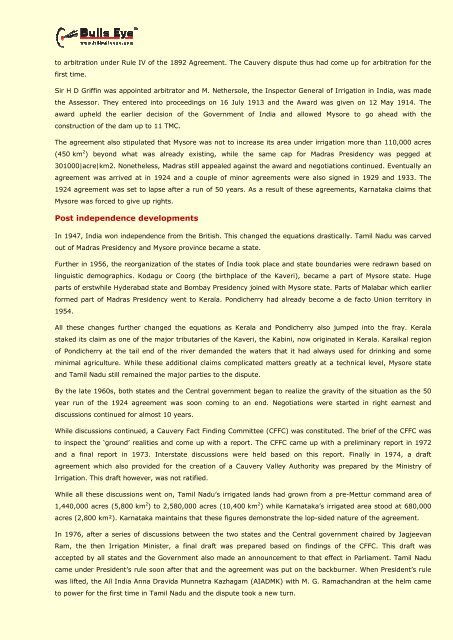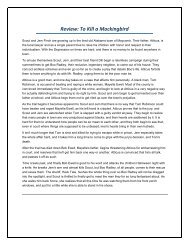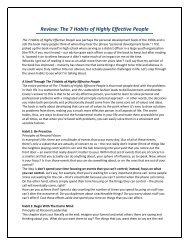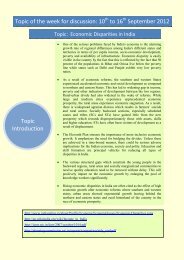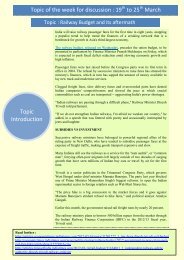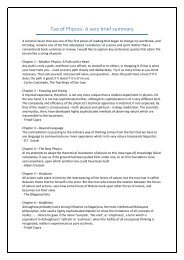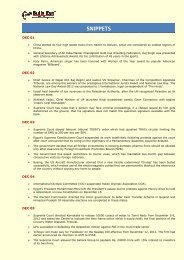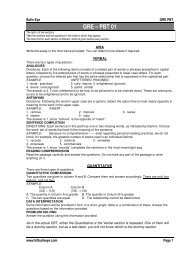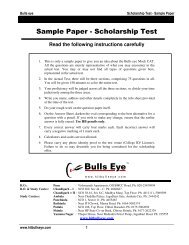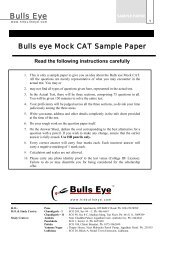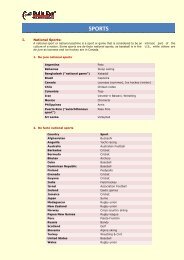KAVERI/CAUVERY WATER DISPUTE - Bulls Eye
KAVERI/CAUVERY WATER DISPUTE - Bulls Eye
KAVERI/CAUVERY WATER DISPUTE - Bulls Eye
Create successful ePaper yourself
Turn your PDF publications into a flip-book with our unique Google optimized e-Paper software.
to arbitration under Rule IV of the 1892 Agreement. The Cauvery dispute thus had come up for arbitration for the<br />
first time.<br />
Sir H D Griffin was appointed arbitrator and M. Nethersole, the Inspector General of Irrigation in India, was made<br />
the Assessor. They entered into proceedings on 16 July 1913 and the Award was given on 12 May 1914. The<br />
award upheld the earlier decision of the Government of India and allowed Mysore to go ahead with the<br />
construction of the dam up to 11 TMC.<br />
The agreement also stipulated that Mysore was not to increase its area under irrigation more than 110,000 acres<br />
(450 km 2 ) beyond what was already existing, while the same cap for Madras Presidency was pegged at<br />
301000|acre|km2. Nonetheless, Madras still appealed against the award and negotiations continued. Eventually an<br />
agreement was arrived at in 1924 and a couple of minor agreements were also signed in 1929 and 1933. The<br />
1924 agreement was set to lapse after a run of 50 years. As a result of these agreements, Karnataka claims that<br />
Mysore was forced to give up rights.<br />
Post independence developments<br />
In 1947, India won independence from the British. This changed the equations drastically. Tamil Nadu was carved<br />
out of Madras Presidency and Mysore province became a state.<br />
Further in 1956, the reorganization of the states of India took place and state boundaries were redrawn based on<br />
linguistic demographics. Kodagu or Coorg (the birthplace of the Kaveri), became a part of Mysore state. Huge<br />
parts of erstwhile Hyderabad state and Bombay Presidency joined with Mysore state. Parts of Malabar which earlier<br />
formed part of Madras Presidency went to Kerala. Pondicherry had already become a de facto Union territory in<br />
1954.<br />
All these changes further changed the equations as Kerala and Pondicherry also jumped into the fray. Kerala<br />
staked its claim as one of the major tributaries of the Kaveri, the Kabini, now originated in Kerala. Karaikal region<br />
of Pondicherry at the tail end of the river demanded the waters that it had always used for drinking and some<br />
minimal agriculture. While these additional claims complicated matters greatly at a technical level, Mysore state<br />
and Tamil Nadu still remained the major parties to the dispute.<br />
By the late 1960s, both states and the Central government began to realize the gravity of the situation as the 50<br />
year run of the 1924 agreement was soon coming to an end. Negotiations were started in right earnest and<br />
discussions continued for almost 10 years.<br />
While discussions continued, a Cauvery Fact Finding Committee (CFFC) was constituted. The brief of the CFFC was<br />
to inspect the ‘ground’ realities and come up with a report. The CFFC came up with a preliminary report in 1972<br />
and a final report in 1973. Interstate discussions were held based on this report. Finally in 1974, a draft<br />
agreement which also provided for the creation of a Cauvery Valley Authority was prepared by the Ministry of<br />
Irrigation. This draft however, was not ratified.<br />
While all these discussions went on, Tamil Nadu’s irrigated lands had grown from a pre-Mettur command area of<br />
1,440,000 acres (5,800 km 2 ) to 2,580,000 acres (10,400 km 2 ) while Karnataka’s irrigated area stood at 680,000<br />
acres (2,800 km²). Karnataka maintains that these figures demonstrate the lop-sided nature of the agreement.<br />
In 1976, after a series of discussions between the two states and the Central government chaired by Jagjeevan<br />
Ram, the then Irrigation Minister, a final draft was prepared based on findings of the CFFC. This draft was<br />
accepted by all states and the Government also made an announcement to that effect in Parliament. Tamil Nadu<br />
came under President’s rule soon after that and the agreement was put on the backburner. When President’s rule<br />
was lifted, the All India Anna Dravida Munnetra Kazhagam (AIADMK) with M. G. Ramachandran at the helm came<br />
to power for the first time in Tamil Nadu and the dispute took a new turn.


